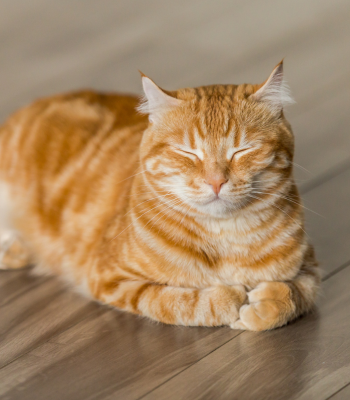Congestive Heart Failure in Cats: Treatment Options and How to Know When It’s Time for Euthanasia
Congestive heart failure (CHF) in cats is a serious condition in which the heart can no longer pump blood efficiently. As the heart’s function declines, fluid begins to accumulate in or around the lungs and other parts of the body, making breathing difficult and impacting quality of life.
CHF is not a disease itself but a result of underlying heart problems — most commonly hypertrophic cardiomyopathy (HCM) in cats. While some cats can live comfortably with CHF for months or even years, others may experience a rapid decline. Many cats diagnosed with congestive heart failure were completely symptom-free prior to their diagnosis.
If your cat has been diagnosed with congestive heart failure, you’re likely facing many difficult decisions. This guide will walk you through the treatment options, what palliative care can look like, and how to know when it might be time to say goodbye. If you aren’t sure and want professional guidance, schedule a comprehensive quality of life teleconsult with one of our compassionate veterinarians:
Treatment Options
Treatment for cats with congestive heart failure falls into two large areas:
- Emergency treatment: for when a cat is actively in heart failure, often requiring oxygen, hospitalization, intensive care, and sometimes procedures to remove fluid from around the lungs or in the belly.
- Maintenance treatment: this consists mainly of medications you give at home and ongoing monitoring.
Emergency Treatment
If your cat is experiencing difficulty breathing, you should take them to an emergency room where aggressive treatment can be initiated and oxygen can be give to help them breathe. In some cases, if there is a fluid build-up around the lungs or in the belly it can be drained.
Maintenance treatment
Most cats with CHF are managed with a combination of medications aimed at reducing fluid buildup, supporting heart function, and improving comfort.
Commonly used drugs include:
- Diuretics (e.g., furosemide and/or spironolactone) – to remove excess fluid from the lungs or body
- ACE inhibitors (e.g., benazepril, enalapril) – to lower blood pressure and reduce heart workload
- Pimobendan – sometimes used to improve heart contraction
- Beta-blockers or calcium channel blockers – in some cases, to control heart rate or rhythm
Your vet may also recommend periodic chest x-rays, echocardiograms, or blood pressure monitoring to guide treatment.
Challenges of treating congestive heart failure in cats
1. Intensity of the medication regimen: cats with congestive heart failure often require multiple medications given multiple times a day. Sometimes a pet parent needs to be able to medicate a pet up to 4 times a day, which can present a major challenge.
2. Frequent veterinary visits: cats with congestive heart failure need frequent monitoring of echocardiogram, electrocardiogram, bloodwork, and blood pressure. Many cats hate going to the vet and these visits can negatively affect their quality of life, in addition to being time-consuming and expensive.
3. Financial burden: medications, monitoring, and in particular hospitalizations can really add up. Visits to the cardiologist can cost between $500 and $1000 and hospitalization for an acute episode of heart failure can cost $5000-$10,000 each time it happens. This can lead to serious financial stress and often feelings of guilt.
4. Emotional toll: Congestive heart failure can be particularly emotionally taxing because episodes can come on so suddenly and be so severe. It also comes with this dread of knowing your pet has a terminal illness and not knowing when another acute episode will occur and when you will have to say goodbye to your pet.
5. The episodic nature of the disease: one of the biggest challenges of this disease is that for many patients, symptoms are episodic and severe – meaning that when a pet is experiencing an episode of congestive heart failure they are in severe respiratory distress, struggle to breathe and are suffering greatly, but between episodes they are mostly normal. This can take a great psychological toll on pet parents and make it difficult to make decisions about euthanasia because pet parents are left with a decision to either say goodbye when their pet is gasping for breath or say goodbye when the pet is relatively normal.
How to Know When It’s Time for Euthanasia
Congestive heart failure can be a particularly challenging disease when it comes to making decisions about euthanasia due to the above challenges.
I highly recommend making a comprehensive end of life care plan as soon as your cat has been diagnosed with congestive heart failure. Similar to an advanced directive in a human, you want to address important care questions like:
- Would you hospitalize your cat if they experienced a severe episode of congestive heart failure?
- Would you take your cat to the hospital for fluid drainage, if repeated fluid drainage was necessary?
- Can you medicate your cat? If you cannot give your cat a pill or liquid medication, treatment may simply not be an option.
- What are the objective set of criteria you will choose for when to elect euthanasia so your cat does not suffer needlessly?
- Do you want to ensure your cat has a home euthanasia instead of passing away at a hospital?
- Is everyone in your family comfortable with this plan?
It is much easier to make these decisions when you are in a relatively calm frame of mind. When we are facing an immediate crisis of possibly losing our pets, it’s easy to make the wrong decisions in a panic. I’ve made this mistake myself.
It’s important to understand that many cats with congestive heart failure can have a good quality of life at home — until a sudden crisis occurs. This makes decision-making especially difficult. Pet parents are often faced with a hard choice:
Do I want to ensure my cat has a peaceful, in-home passing — which may mean saying goodbye while they’re still relatively stable?
Or am I willing to wait until a medical emergency arises, knowing that goodbye may need to happen in a stressful hospital setting in order to have more time together?
This is a very personal decision and the right answer is different for every family. If a pet parent is able to continuously monitor their pet, sometimes we can catch acute episodes before they become extremely severe. However, it is often a matter of hours from when a pet starts to show signs of an acute episode to when the pet is in full-blown respiratory distress.
However, if you’re like many of us and work long hours and need to leave your pet alone for more than a few hours, often the kindest thing is to say goodbye with a peaceful euthanasia at home when they are having a good day.
As a hospice veterinarian, I believe strongly in quality of life, and have personally found that many clients have regretted waiting until it is an emergency because they regret that their cat was scared in their last moments.
Signs That Euthanasia May Be the Kindest Option for Cats with Congestive Heart Failure
- Repeated episodes of respiratory distress – If your cat has to be rushed to the hospital repeatedly for difficulties breathing, it may be time to consider euthanasia.
- Aortic Thromboembolism (ATE) Episodes – If your cat experiences a sudden loss of mobility in the hind legs due to a clot, the pain and distress can be severe. Many pet parents choose to euthanize their cat when this happens because many cats will never recover and the likelihood of recurrence is extremely high.
- Need for frequent fluid drainage – if fluid is starting to build up around the lungs or in the belly and you are having to take your cat for repeated visits for drainage, it may be time to consider euthanasia.
- General decrease in quality of life – If your cat is lethargic all the time, hiding often, losing weight, losing interest in food or attention they may be telling you they are suffering more than they are enjoying life.
- Lack of Response to Medication – If treatments no longer improve breathing, circulation, or general comfort, the disease may have reached its final stages.
- Owner factors – if you are starting to get concerned that you can’t leave your cat alone for more than a few hours or something terrible might happen, or if you are worried you may have to rush your cat to the hospital for euthanasia and would prefer them to pass peacefully at home, it may be time to consider euthanasia.
Conclusion
I hope this guide has helped you think through end of life decisions in cats with congestive heart failure. Remember, no matter what path you choose, if you prioritize your cat’s quality of life, you will do right by them.
If you are not sure what to do and would like more guidance and support, we offer comprehensive teleconsults with compassionate veterinarians. We will review all your cat’s medical records and history, discuss all your options, and help you formulate the most compassionate and loving plan for your family.
And when it does come time, Paws at Peace offers in-home euthanasia in all five boroughs of NYC (Manhattan, Bronx, Brooklyn, Queens, Staten Island) to help your cat pass peacefully at home, surrounded by family. Home euthanasia can provide your cat with a gentle and dignified transition without the stress of a veterinary visit.

